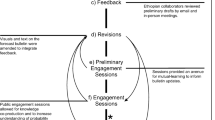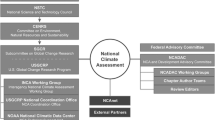Abstract
In order for a scientific innovation to reach a wide audience it needs to travel through diverse networks and be understandable to a variety of people. This paper focuses on networks of stakeholders involved in the diffusion of seasonal climate forecasts. It is argued that understanding stakeholder networks is key to determining the opportunities and barriers to the flow of forecast information, which could enable more focused forecast dissemination. Lesotho is used as a case study where Stakeholder Thematic Networks (STNs) are used as a novel method for investigating forecast dissemination. STNs enable qualitative information to be analysed through semi-quantitative mapping of relationships that enable the networks and scales of linkages to be visualised. This illustrates the types of nodes and channels of seasonal forecast information flow and so enables existing or emerging patterns of dissemination to be uncovered. Sub-networks that exist for purposes other than climate information dissemination are identified as salient sub-networks for focusing development of future forecast dissemination. These existing sub-networks enable stakeholder needs to be addressed and decrease the need for new networks to be established. By using these sub-networks, information relating to climate variability can be mainstreamed into existing development pathways. This is critical to recognise if innovations relating to climate information are to be used to improve climate change adaptation.
Similar content being viewed by others
References
Agrawala, S. and Broad, K.: 2002, ‘Technology Transfer Perspective on Climate Forecast Applications’, in Laet, M. D. (ed.) Research in Science and Technology Studies: Knowledge and Technology Transfer, pp. 45–69.
Archer, E. R. M.: 2003, ‘Identifying Underserved End-User Groups in the Provision of Climate Information’, Bull. Amer. Meteorol. Soc. 84, 1525–1532.
Bakker, K., Downing, T., Garrido, A., Giansante, C., Iglesias, E., del Moral, L., Pedregal, B., and Riesco, P.: 1999, Societal and Institutional Responses to Climate Change and Climatic Hazards: Managing Changing Flood and Drought Risk, SIRCH, Working Paper No. 3.
Basher, R., Clark, C., Dilley, M., and Harrison, M.: 2000, Coping with Climate: A Way Forward. A Multi-Stakeholder Review of Regional Climate Outlook Forums Concluded at an International Workshop, October 16-20, Pretoria, South Africa, International Research Institute for Climate Prediction, Palisades.
Bharara, L. P. and Seeland, K.: 1994, ‘Indigenous Knowledge and Drought in the Arid Zone of Rajasthan’, Internationales Asienforum 25, 53–71.
Blench, R.: 1999, ‘Seasonal Climatic Forecasting: Who Can Use It and How Should It Be Disseminated?’ Natural Resour. Perspect. 47.
Bohn, L.: 2000, ‘The Use of Climate Information in Commercial Agriculture in Southeast Africa’, Phys. Geog. 21, 57–67.
Broad, K., Pfaff, A. P., and Glantz, M. H.: 2002, ‘Effective and Equitable Dissemination of Seasonalto-Interannual Climate Forecasts: Policy Implications from the Peruvian Fishery during El Niño 1997-98’, Clim. Change 54, 415–438.
Castells, M.: 1996, The Rise of the Network Society, Blackwell Publishers.
Chakela, Q. K. (ed.): 1999, State of Environment in Lesotho, 1997, National Environment Secretariat, Maseru.
Downing, T. E., Moss, S., and Pahl-Wostl, C.: 2000, ‘Understanding Climate Policy Using Participatory Agent-Based Social Simulation’, Multi-Agent-Based Simulation: Second International Workshop, Boston, MA, Springer.
Eakin, H.: 1999, ‘Seasonal Climate Forecasting and the Relevance of Local Knowledge’, Phys. Geog. 20, 447–460.
Eakin, H.: 2000, ‘Smallholder Maize Production and Climatic Risk: A Case Study from Mexico’, Clim. Change 45, 19–35.
Ferguson, J.: 1997, The Anti-Politics Machine: ‘Development’, Depolitization, and Bureaucratic Power in Lesotho, University of Minnesota Press, Minneapolis.
Gay, J. and Hall, D.: 2000, Poverty and Livelihoods in Lesotho, 2000. More than aMapping Exercise, Maseru.
Giansante, C. (ed.): 2000, Adaptive Responses to Hydrological Risk: An Analysis of Stakeholders, Departamento de Geografía Humana, Universidad de Sevilla.
Gibberd, V., Rook, J., Sear, C. B., and Williams, J. B.: 1996, Drought Risk Management in Southern Africa: The Potential of Long Lead Climate Forecasts for Improved Drought Management, Report for ODA and the World Bank.
GIEWS/FAO: 2000, Food Supply Situation and Crop Prospects in Southern Africa.
Harrison, M. S. J.: 1984, ‘The Annual Rainfall Cycle of the Central Interior of South Africa’, South African Geogr. J. 66, 47–64.
Horta, K.: 1995, ‘The Mountain Kingdom's White Oil: The Lesotho Highlands Water Project’, Ecologist 25, 227–231.
Hulme, M., Biot, Y., Borton, J., Buchanan-Smith, M., Davies, S., Folland, C., Nicholds, N., Seddon, D., and Ward, N.: 1992, ‘Seasonal Rainfall Forecasting for Africa. Part II: Application and Impact Assessment’, Int. J. Environ. Stud. 40, 103–121.
Hyden, L. and Sekoli, T.: 2000, ‘Possibilities to Forecast Early Summer Rainfall in the Lesotho Lowlands from the El-Niño/Southern Oscillation’, Water SA 26, 83–90.
Jordan, A. and O'Riordan, T.: 1995, Institutional Adaptation to Global Environmental Change (I): Social Institutions, Policy Change and Social Learning, CSERGE Working Paper GEC 95-20.
Klopper, E.: 1999, ‘The Use of Seasonal Forecasts in South Africa during the 1997/98 Rainfall Season’, Water SA 25, 311–317.
Landman, W. A., Mason, S. J., Tyson, P. D., and Tennant, W. J.: 2001, ‘Retro-Active Skill of Multi-Tiered Forecasts of Summer Rainfall over Southern Africa’, Int. J. Clim. 21, 1–19.
Mahajan, V. and Peterson, R. A.: 1985, Models for Innovation Diffusion. A Sage University Paper, Quantitative Applications in the Social Sciences Series, Vol. 48, Sage Publications.
Mason, S. J.: 1997, ‘Review of Recent Developments in Seasonal Forecasting of Rainfall’, Water SA 23, 57.
Mason, S. J.: 1998, ‘Seasonal Forecasting of South African Rainfall Using a Non-Linear Discriminant Analysis Model’, Int. J. Clim. 18, 147–164.
Mason, S. J., Joubert, A. M., Cosijn, C., and Crimp, S. J.: 1996, ‘Review of Seasonal Forecasting Techniques and their Applicability to Southern Africa’, Water SA 22, 203–209.
Ministry of Natural Resources: 2000, National Report on Climate Change: Lesotho, Maseru.
Mitchell, J. C., (ed.): 1969, Social Networks in Urban Settings: Analyses of Personal Relationships in Central African Towns, Manchester University Press, Manchester.
Mjelde, J.W., Thompson, T. N., Nixon C. J., and Lamb, P. J.: 1997, ‘Utilising a Farm-Level Decision Model to Help Prioritise Future Climate Prediction Research Needs’, Meteorol. Appl. 4, 161–170.
Mukhala, E., Walker, S., and van den Berg, J.: 2000, ‘Communication of Seasonal Climate Forecasts between Meteorological Scientists and Farmers in the Free State Province’, Southern African Climate Outlook Forum, Gaborone, Botswana.
Murphy, A.: 1997, ‘Forecast Verification’, in Katz, R. and Murphy, A. (eds.), Economic Value of Weather and Climate Forecasts, Cambridge University Press, pp. 19–74.
Murphy, S., Washington, R., Downing, T. E., Martin, R. V., Ziervogel, G., Preston, P., Todd, M., Butterfield, R., and Briden, J.: 2001, ‘Seasonal Forecasting for Climate Hazards: Prospects and Responses’, Natural Hazards 23, 171–196.
O'Brien, K., Sygna, L., Næss, L. O., Kingamkono, R., and Hochobeb, B.: 2000, Is Information Enough? User Responses to Seasonal Climate Forecasts in Southern Africa, Report No. 2000-03, CICERO, Oslo.
Orlove, B. and Tosteson, J.: 1999, ‘The Application of Seasonal to Interannual Climate Forecasts Based on ENSO Events: Lessons from Australia, Brazil, Ethiopia, Peru, and Zimbabwe’.
Palmer, T. N. and Anderson, D.: 1994, ‘The Prospects for Seasonal Forecasting-A Review Paper’, Quart. J. Roy. Meteorol. Soc. 120, 755–793.
Patt, A. and Gwata, C.: 2002, ‘Effective Seasonal Climate Forecast Applications: Examining Constraints for Subsistence Farmers in Zimbabwe’, Global Environ. Change: Hum. Pol. Dim. 12, 185–195.
Pepin, N.: 1996, ‘Indigenous Knowledge Concerning Weather: The Example of Lesotho’, Weather 51, 242–248.
Pfaff, A., Broad, K., and Glantz, M.: 1999, ‘Who Benefits from Climate Forecasts?’ Nature 397, 645–646.
Phillips, J. G., Makaudze, E., and Unganai, L.: 2001, ‘Current and Potential Use of Climate Forecasts for Resource-poor Farmers in Zimbabwe’, in Impacts of El Niño and Climate Variability on Agriculture, American Society of Agronomy Special Publication Series, pp. 87–100.
Rayner, S. and Malone, E. L. (eds.): 1998, Human Choice and Climate Change: Volume 1, Batelle Press, Columbus.
Rogers, E. M.: 1995, Diffusion of Innovations, 4th edn., The Free Press, New York, NY.
Rogers, E. M. and Kincaid, D. L.: 1981, Communication Networks: Towards a New Paradigm for Research, Free Press, New York, NY.
Roncoli, C., Kirshen, P., Ingram, K., and Flitcroft, I.: 2000, ‘Opportunities and Constraints to Using Seasonal Precipitation Forecasting to Improve Agricultural Production Systems and Livelihood Security in the Sahel-Sudan Region: A Case Study of Burkina Faso, CFAR-Phase 1’, IRI Forum on Climate Predictions, Agriculture and Development, New York, 26-28 April.
Scoones, I.: 1997, Hazards and Opportunities: Farming Livelihoods in Dryland Africa, Lessons from Zimbabwe, Zed Books Ltd, p. 267.
Scott, J.: 1991, Social Network Analysis: A Handbook, Sage Publications.
Sivakumar, M. V. K., Gommes, R., and Baier, W.: 2000, ‘Agrometeorology and Sustainable Agriculture’, Agric. For. Meteorol. 103, 11–26.
Stack, J.: 1998, Drought Forecasts and Warning in Zimbabwe: Actors, Linkages and Information Flows, Department of Agricultural Economics and Extension, University of Zimbabwe Working Paper.
Tyson, P. D.: 1986, Climate Change and Variability in Southern Africa, Oxford University Press, Cape Town.
Valente, T. W.: 1995, Network Models of the Diffusion of Innovations, Hampton Press, Cresskil, NJ.
Valente, T. W.: 1996, ‘Social Network Thresholds in the Diffusion of Innovation’, Soc. Net. 18, 69–89.
Vogel, C.: 2000, ‘Usable Science: An Assessment of Long-Term Seasonal Forecasts among Farmers in Rural Areas of South Africa’, South African Geogr. J. 82, 107–116.
Waites, B.: 2000, ‘The Lesotho Highlands Water Project’, Geography 85, 369–374.
Ward, M. N., Unganai, L., and Garanganga, B.: 1998, ‘Verification of the 1997/98 ENSARCOF Seasonal Rainfall Outlook Maps-Issues,Methodology and Results’, http://www.meto.govt.uk/sec5/ NWP_seasonal/NWP_pef_ensarcof/report2/projassess2.html.
Washington, R. and Downing, T. E.: 1999, ‘Seasonal Forecasting of African Rainfall: Prediction, Responses and Household Food Security’, Geogr. J. 165, 255–274.
Wilken, G.: 1982, Agro-Climatic Hazard Perception, Prediction and Risk-Avoidance Strategies in Lesotho, Department of Geography, Colorado State University.
Ziervogel, G.: 2001, ‘Global Science, Local Problems: Seasonal Forecast Use in a Basotho Village’, Open Meeting of the Global Environmental Change Research Community, Rio de Janeiro, 6-8 October 2001.
Ziervogel, G.: in press, ‘Targeting Seasonal Climate Forecasts for Integration into Household Level Decisions: The Case of Smallholder Farmers in Lesotho’, Geogr. J.
Ziervogel, G. and Calder, R.: 2003, ‘Climate Variability and Rural Livelihoods: Assessing the Impact of Seasonal Climate Forecasts in Lesotho’, Area 35, 403–417.
Author information
Authors and Affiliations
Rights and permissions
About this article
Cite this article
Ziervogel, G., Downing, T.E. Stakeholder Networks: Improving Seasonal Climate Forecasts. Climatic Change 65, 73–101 (2004). https://doi.org/10.1023/B:CLIM.0000037492.18679.9e
Issue Date:
DOI: https://doi.org/10.1023/B:CLIM.0000037492.18679.9e




